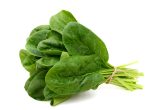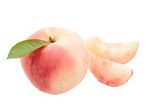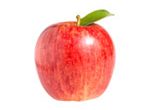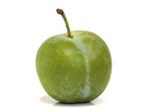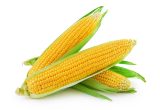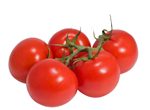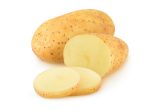Apricot

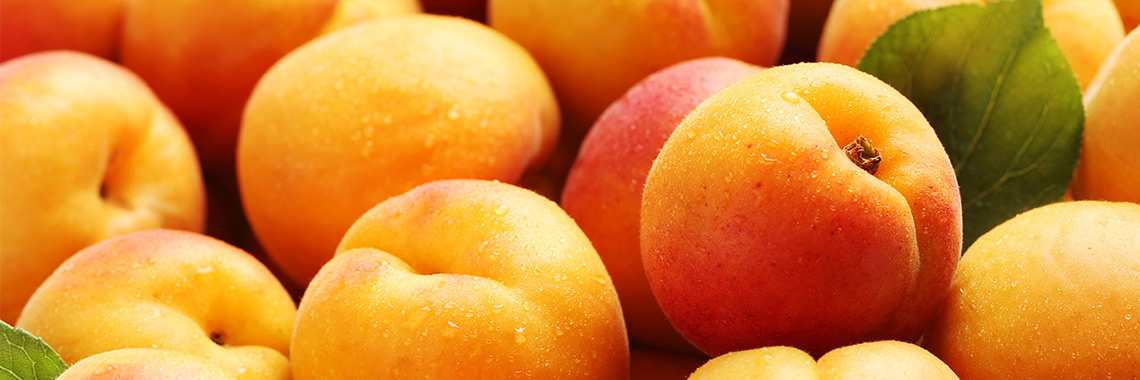
Description
The apricot tree (Prunus armeniaca L.) belongs to the Rosaceae family, and to the Prunophora subfamily.
- It is believed to originate from the Tien-Shan mountains in Central Asia (Hormaza, 2007). It is found on all five continents (Bailey, 1975), but is mostly cultivated in the Mediterranean region (FAO, 2017).
- Apricots thrive best in arid to temperate climates (Bailey, 1975).
PHYSICAL AND ORGANOLEPTIC CHARACTERISTICS
- When it reaches its optimal degree of ripeness, the apricot is a fruit of a beautiful orange colour. Its flesh is pulpy, sweet and juicy (Les fruits et légumes frais).
- It is rich in β-carotene, a pigment of the carotenoid family responsible for its orange colour (Simmonds, 2016).
- There are apricot cultivars with blushing skin. This blushing is thought to be due to an elevated accumulation of three anthocyanins in the skin during fruit ripening: cyanidin-3-O-glucoside, cyanidin-3-O-rutinoside and peonidin-3-O-rutinoside (Xi, 2019).
- Sucrose and glucose give apricots their sweet taste. Their sugar concentration is reported to increase rapidly during development, with a predominance of glucose that is believed to evolve to a predominance of sucrose during ripening (Xi, 2016).
- The slight acidity of apricot comes from malic acid, an organic acid (Fan, 2017).
- Eighteen aromatic compounds have been identified in the volatile fraction of the fruit, including terpenes and aldehydes, which are believed to significantly decrease during development, but also apocarotenoids and lactones, which are reported to significantly increase during ripening (Xi, 2016).
COMPOSITION CHARACTERISTICS (excluding macronutrients, vitamins and minerals)
- Natural organic acids, mainly malic acid and citric acid, are present in significant quantities in apricots (Aubert, 2007; Berardinelli, 2010).
- Apricot contains a notable amount of polyphenols, in particular flavanols, flavonols (flavonoids) and hydroxycinnamic acids (phenolic acids). They reportedly confer hepatoprotective, anti-inflammatory and antihypertensive properties on the fruit (Iglesias-Carres, 2019).
- Apricot’s richness in polyphenols and carotenoids is believed to give it biological effects that are protective of the liver and heart (Fratianni, 2018).
- However, polyphenol content may vary between varieties and is thought to depend on ripeness, region and growing system (Iglesias-Carres, 2019).
RAW
The average energy content of apricots is 42.6 Kcal per 100 g, i.e. 180 kJ. For a medium-sized fruit (45 g) the apricot therefore provides less than 20 kcal.
Average composition per 100 g of food. The water content is not taken into account.
COMPOSITION TABLES
For each nutrient, the tables provide information on the average amount* as well as the minimum and maximum amounts* per 100 g net of apricots.
Average composition given as an indication: the following values are approximate and depend on variety, season, ripeness, cultivation conditions, etc. The data on polyphenols is taken from the Phenol-Explorer 3.0 database. All other data is taken from the Ciqual nutritional composition of foods table (2017) – ANSES, except for the Vitamin A equivalent which corresponds to the division of the Beta-carotene content by 6.
For each nutrient (except polyphenols), the tables provide information on the average amount, as well as what this represents as a percentage of the Dietary Reference Values (DRVs)*. The DRVs are a comprehensive set of nutritional recommendations and reference values, such as the population reference intakes, average requirements, appropriate level of consumption and minimum consumption threshold.
MACRONUTRIENTS
| Constituent (g) | Average content |
Min-Max per 100g |
DRV% |
|---|---|---|---|
| Water | 87,1 | 86,10 - 91 | - |
| Fibers | 1,70 | 1,30 - 2,50 | - |
| Carbohydrates | 9,01 | - | 3,47 |
| Sugars | 6,70 | - | 7,44 |
| Lipids | < 0,50 | 0,30 - NC | - |
| Saturated fat | < 0,01 | NC - 0,027 | - |
| Protein | 0,81 | 0,63 - 1,40 | 1,62 |
| Constituent (g) | Amount | Min-Max | DRV% |
|---|---|---|---|
| Water | Ciqual 2020 (valeur issue des analyses Ciqual-Aprifel 2017) | - | - |
| Fibers | Ciqual 2020 (valeur issue des analyses Ciqual-Aprifel 2017) | - | - |
| Carbohydrates | Ciqual 2020 | - | Règlement (UE) N°1169/2011 du parlement Européen, et du conseil du 25 octobre 2011 |
| Sugars | Ciqual 2020 (valeur issue des analyses Ciqual-Aprifel 2017) | - | Règlement (UE) N°1169/2011 du parlement Européen, et du conseil du 25 octobre 2011 |
| Lipids | Ciqual 2020 (valeur issue des analyses Ciqual-Aprifel 2017) | - | Règlement (UE) N°1169/2011 du parlement Européen et du conseil du 25 octobre 2011 |
| Saturated fat | Ciqual 2020 (valeur issue des analyses Ciqual-Aprifel 2017) | - | Règlement (UE) N°1169/2011 du parlement Européen et du conseil du 25 octobre 2011 |
| Protein | Ciqual 2020 | - | Règlement (UE) N°1169/2011 du parlement Européen et du conseil du 25 octobre 2011 |
Zoom on carbohydrates:
- The energy in apricots comes mainly from their carbohydrates, amounting to 9.01 g per 100 g.
- Their carbohydrate content is lower than the average amount found in fresh fruit: about 11.31 g per 100 g.
- The carbohydrates in apricots are mainly sucrose (3.40 g per 100 g), glucose (2 g per 100 g) and fructose (1.30 g per 100 g).
Zoom on fibres:
- The amount of fibre in apricots (1.70 g per 100 g) is lower than the average quantity found in fresh fruit (2.77 g per 100 g).
Zoom on proteins:
- The protein content of apricots (0.81 g per 100 g) is lower than the average amount found in fresh fruit: 0.93 g per 100 g.
Zoom on lipids:
- Apricots are fat-free* as they contain less than 0.5 g of fat per 100 g.
*Regulation (EC) No. 1924/2006 of the European Parliament and of the Council of 20 December 2006 on nutrition and health claims made on foods.
MINERALS AND TRACE ELEMENTS
| Constituent | Average content |
Min-Max per 100g |
DRV% |
|---|---|---|---|
| Calcium (mg) | 15 | 6,97 - 28 | 1,88 |
| Chloride (mg) | < 20 | - | - |
| Copper (mg) | 0,06 | 0,046 - 0,17 | 6 |
| Iron (mg) | 0,19 | 0,16 - 0,62 | 1,36 |
| Iodine (µg) | < 20 | - | - |
| Magnesium (mg) | 8,40 | NC - 14 | 2,24 |
| Manganese (mg) | 0,07 | 0,057 - 0,10 | 3,50 |
| Phosphorus (mg) | 22 | 13 - 28 | 3,14 |
| Potassium (mg) | 260 | 214 - 322 | 13 |
| Selenium (µg) | < 20 | 10 - NC | - |
| Sodium (mg) | < 5 | 0 - NC | - |
| Zinc (mg) | 0,09 | NC - 0,32 | 0,90 |
| Constituent | Amount | Min-Max | DRV% |
|---|---|---|---|
| Calcium (mg) | Ciqual 2020 (valeur issue des analyses Ciqual-Aprifel 2017) | - | Règlement (UE) N°1169/2011 du parlement Européen et du conseil du 25 octobre 2011 |
| Chloride (mg) | Ciqual 2020 (valeur issue des analyses Ciqual-Aprifel 2017) | - | Règlement (UE) N°1169/2011 du parlement Européen et du conseil du 25 octobre 2011 |
| Copper (mg) | Ciqual 2020 (valeur issue des analyses Ciqual-Aprifel 2017) | - | Règlement (UE) N°1169/2011 du parlement Européen et du conseil du 25 octobre 2011 |
| Iron (mg) | Ciqual 2020 (valeur issue des analyses Ciqual-Aprifel 2017) | - | Règlement (UE) N°1169/2011 du parlement Européen et du conseil du 25 octobre 2011 |
| Iodine (µg) | Ciqual 2020 (valeur issue des analyses Ciqual-Aprifel 2017) | - | Règlement (UE) N°1169/2011 du parlement Européen et du conseil du 25 octobre 2011 |
| Magnesium (mg) | Ciqual 2020 (valeur issue des analyses Ciqual-Aprifel 2017) | - | Règlement (UE) N°1169/2011 du parlement Européen et du conseil du 25 octobre 2011 |
| Manganese (mg) | Ciqual 2020 (valeur issue des analyses Ciqual-Aprifel 2017) | - | Règlement (UE) N°1169/2011 du parlement Européen et du conseil du 25 octobre 2011 |
| Phosphorus (mg) | Ciqual 2020 (valeur issue des analyses Ciqual-Aprifel 2017) | - | Règlement (UE) N°1169/2011 du parlement Européen et du conseil du 25 octobre 2011 |
| Potassium (mg) | Ciqual 2020 (valeur issue des analyses Ciqual-Aprifel 2017) | - | Règlement (UE) N°1169/2011 du parlement Européen et du conseil du 25 octobre 2011 |
| Selenium (µg) | Ciqual 2020 (valeur issue des analyses Ciqual-Aprifel 2017) | - | Règlement (UE) N°1169/2011 du parlement Européen et du conseil du 25 octobre 2011 |
| Sodium (mg) | Ciqual 2020 (valeur issue des analyses Ciqual-Aprifel 2017) | - | - |
| Zinc (mg) | Ciqual 2020 (valeur issue des analyses Ciqual-Aprifel 2017) | - | Règlement (UE) N°1169/2011 du parlement Européen et du conseil du 25 octobre 2011 |
Zoom on minerals and trace elements:
- The potassium content of apricots is significant at 260 mg per 100 g, corresponding to 13% of DRVs.
- The other minerals and trace elements are present in quantities representing less than 7% of DRVs.
VITAMINS
| Constituent | Average content |
Min-Max per 100g |
DRV% |
|---|---|---|---|
| Provitamin A Beta-carotene (µg) | 2 350 | 615 - NC | - |
| Vitamin A equivalent (µg) | 391,67 | 102,50 - NC | 48,96 |
| Vitamin B1 (mg) | 0,03 | - | 2,73 |
| Vitamin B2 (mg) | 0,013 | NC - 0,04 | 0,93 |
| Vitamin B3 (mg) | < 0,10 | NC - 0,60 | - |
| Vitamin B5 (mg) | 0,19 | NC - 0,24 | 3,17 |
| Vitamin B6 (mg) | 0,054 | - | 3,86 |
| Vitamin B9 (µg) | 7,60 | NC - 9 | 3,80 |
| Vitamin C (mg) | 2,55 | NC - 10 | 3,19 |
| Vitamin E (mg) | 0,70 | 0,61 - 0,89 | 5,83 |
| Vitamin K1 (µg) | < 0,80 | NC - 3,30 | - |
| Constituent | Amount | Min-Max | DRV% |
|---|---|---|---|
| Provitamin A Beta-carotene (µg) | Ciqual 2020 (valeur issue des analyses Ciqual-Aprifel 2017) | - | - |
| Vitamin A equivalent (µg) | Calcul à partir de la valeur Provitamine A Béta-carotène* | - | Règlement (UE) N°1169/2011 du parlement Européen et du conseil du 25 octobre 2011 |
| Vitamin B1 (mg) | Ciqual 2020 | - | Règlement (UE) N°1169/2011 du parlement Européen et du conseil du 25 octobre 2011 |
| Vitamin B2 (mg) | Ciqual 2020 (valeur issue des analyses Ciqual-Aprifel 2017) | - | Règlement (UE) N°1169/2011 du parlement Européen et du conseil du 25 octobre 2011 |
| Vitamin B3 (mg) | Ciqual 2020 (valeur issue des analyses Ciqual-Aprifel 2017) | - | Règlement (UE) N°1169/2011 du parlement Européen et du conseil du 25 octobre 2011 |
| Vitamin B5 (mg) | Ciqual 2020 (valeur issue des analyses Ciqual-Aprifel 2017) | - | Règlement (UE) N°1169/2011 du parlement Européen et du conseil du 25 octobre 2011 |
| Vitamin B6 (mg) | Ciqual 2020 (valeur issue des analyses Ciqual-Aprifel 2017) | - | Règlement (UE) N°1169/2011 du parlement Européen et du conseil du 25 octobre 2011 |
| Vitamin B9 (µg) | Ciqual 2020 (valeur issue des analyses Ciqual-Aprifel 2017) | - | Règlement (UE) N°1169/2011 du parlement Européen et du conseil du 25 octobre 2011 |
| Vitamin C (mg) | Ciqual 2020 (valeur issue des analyses Ciqual-Aprifel 2017) | - | Règlement (UE) N°1169/2011 du parlement Européen et du conseil du 25 octobre 2011 |
| Vitamin E (mg) | Ciqual 2020 (valeur issue des analyses Ciqual-Aprifel 2017) | - | Règlement (UE) N°1169/2011 du parlement Européen et du conseil du 25 octobre 2011 |
| Vitamin K1 (µg) | Ciqual 2020 (valeur issue des analyses Ciqual-Aprifel 2017) | - | Règlement (UE) N°1169/2011 du parlement Européen et du conseil du 25 octobre 2011 |
Zoom on vitamins:
- Apricots are high in vitamin A as they provide the equivalent of 48.96% of DRVs, i.e. 391.67 µg per 100 g. The total carotenoid content of apricot peel is 2 to 3 times higher than that of the flesh (Ruiz, 2005).
According to the Ciqual 2020 table, apricots are the fruit with the highest beta-carotene content after melons. - The other vitamins are present in quantities representing less than 6% of DRVs.
*Calculation made: Beta Carotene / 6 + retinol
POLYPHENOLS
| Constituent (mg) | Average content |
Min-Max per 100mg |
|---|---|---|
| Flavonoids (mg) | 15,31 | - |
| of which Flavonols (mg) | 6,71 | - |
| of which Flavanols (mg) | 8,60 | - |
| Phenolic Acids (mg) | 16,78 | - |
| of which Hydroxybenzoic acids (mg) | 16,78 | - |
| Total polyphenols | 32,09 | - |
| Constituent (mg) | Amount | Min-Max |
|---|---|---|
| Flavonoids | Etude CTIFL-Aprifel 2017-2018 - Méthode utilisée : Chromatographie | - |
| of which Flavonols | Etude CTIFL-Aprifel 2017-2018 - Méthode utilisée : Chromatographie | - |
| of which Flavanols | Etude CTIFL-Aprifel 2017-2018 - Méthode utilisée : Chromatographie | - |
| Phenolic Acids | Etude CTIFL-Aprifel 2017-2018 - Méthode utilisée : Chromatographie | - |
| of which Hydroxybenzoic acids | Etude CTIFL-Aprifel 2017-2018 - Méthode utilisée : Chromatographie | - |
| Total polyphenols | Etude CTIFL-Aprifel 2017-2018 - Méthode utilisée : Chromatographie | - |
Zoom on polyphenols:
- Polyphenols are substances with an antioxidant effect.
- The total polyphenol content of apricots is well below the average amount for fruits, which is 65.34 mg per 100 g.
*Regulation (EU) N°1169/2011 of the European Parliament and of the Council of 25 October 2011 for all DRVs, except those relating to fibre (source: Afssa, 2002. Dietary fibre: definitions, dosage methods, nutrition claims).
**Definition given by EFSA.
Nutrition and health claims
According to the definitions of nutrition claims as set out in Regulation (EC) No 1924/2006 on nutrition and health claims, and in view of the composition of apricots, the following claims may be used:
Nutrition claims of apricot:
- Fat-free (100 g of apricots contain less than 0.5 g of fat).
- High in vitamin A (100 g of apricots provide more than 30% of DRVs).
Health claims (for a consumption of 100 g of apricots):
Vitamin A
- Vitamin A plays a role in the process of cell specialisation.
- Vitamin A contributes to:
- maintenance of normal skin,
- maintenance of normal mucous membranes,
- maintenance of normal vision,
- normal iron metabolism,
- normal functioning of the immune system.
References
- Afssa, 2002. Les fibres alimentaires : définitions, méthodes de dosage, allégations nutritionnelles
- Bourguiba H, Audergon JM, Krichen L, Trifi-Farah N, Mamouni A, Trabelsi S, D’Onofrio C, Asma BM, Santoni S, Khadari B. Loss of genetic diversity as a signature of apricot domestication and diffusion into the Mediterranean Basin. BMC Plant Biol. 2012 Apr 17;12:49.
- Cossu A, Posadino AM, Giordo R, Emanueli C, Sanguinetti AM, Piscopo A, Poiana M, Capobianco G, Piga A, Pintus G. Apricot melanoidins prevent oxidative endothelial cell death by counteracting mitochondrial oxidation and membrane depolarization. PLoS One. 2012;7(11):e48817.
- Greger V, Schieberle P. characterization of the key aroma compounds in apricots (Prunus armeniaca) by application of the molecular sensory science concept. J Agric Food Chem. 2007 Jun 27;55(13):5221-8.
- Krichen L, Audergon JM, Trifi-Farah N. Relative efficiency of morphological characters and molecular markers in the establishment of an apricot core collection. Hereditas. 2012 Oct;149(5):163-72.
- Martin C, Herrero M, Hormaza JI. Molecular characterization of apricot germplasm from an old stone collection. PLoS One. 2011;6(8):e23979.
- Melgarejo P, Calin-Sanchez A, Carbonell-Barrachina AA, Martinez-Nicolas JJ, Legua P, Martinez R, Hernandez F. Antioxidant activity, volatile composition and sensory profile of four new very-early apricots (Prunus armeniaca L.) J Sci Food Agric. 2014 Jan 15;94(1):85-94.
- Neveu V, Perez-Jiménez J, Vos F, Crespy V, du Chaffaut L, Mennen L, Knox C, Eisner R, Cruz J, Wishart D, Scalbert A. (2010) Phenol-Explorer: an online comprehensive database on polyphenol contents in foods. Database, doi: 10.1093/database/bap024. Full text (free access)
- Stahl W, Sies H. Bioactivity and protective effects of natural carotenoids. Biochim Biophys Acta. 2005 May 30;1740(2):101-7.
- Règlement (CE) N° 1924/2006 du Parlement européen et du Conseil du 20 décembre 2006 concernant les allégations nutritionnelles et de santé portant sur les denrées alimentaires.
- Règlement (UE) N°432/2012 de la Commission du 16 mai 2012 établissant une liste des allégations de santé autorisées portant sur les denrées alimentaires, autres que celles faisant référence à la réduction du risque de maladie ainsi qu’au développement et à la santé infantiles.
- Règlement (UE) n°1169/2011 du Parlement européen et du Conseil du 25 octobre 2011 concernant l’information des consommateurs sur les denrées alimentaires, modifiant les règlements (CE) n°1924/2006 et (CE) n°1925/2006 du Parlement européen et de Conseil et abrogeant la directive 87/250/CEE de la Commission, la directive 90/496/CEE du Conseil, la directive 1999/10/CE de la Commission, la directive 200/13/CE du Parlement européen et du Conseil, les directives 2002/67/CE et 2008/5/CE de la Commission et le règlement (CE) n°608/2004 de la Commission.
- Rothwell JA, Urpi-Sarda M, Boto-Ordoñez M, Knox C, Llorach R, Eisner R, Cruz J, Neveu V, Wishart D, Manach C, Andres-Lacueva C, Scalbert A. (2012) Phenol-Explorer 2.0: a major update of the Phenol-Explorer database integrating data on polyphenol metabolism and pharmacokinetics in humans and experimental animals. Database, doi: 10.1093/database/bas031. Full text (free access)
- Rothwell JA, Pérez-Jiménez J, Neveu V, Medina-Ramon A, M’Hiri N, Garcia Lobato P, Manach C, Knox K, Eisner R, Wishart D, Scalbert A. (2013) Phenol-Explorer 3.0: a major update of the Phenol-Explorer database to incorporate data on the effects of food processing on polyphenol content. Database, 10.1093/database/bat070. Full text (free access)
- Table de composition nutritionnelle des aliments CIQUAL (2013) – via le site internet www.anses.fr, consultée le 30/06/2014






